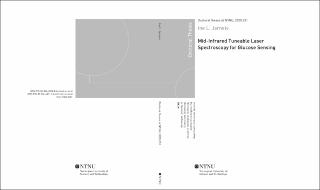| dc.contributor.advisor | Aksnes, Astrid | |
| dc.contributor.author | Jernelv, Ine L. | |
| dc.date.accessioned | 2020-08-05T11:10:59Z | |
| dc.date.available | 2020-08-05T11:10:59Z | |
| dc.date.issued | 2020 | |
| dc.identifier.isbn | 978-82-326-4811-5 | |
| dc.identifier.issn | 1503-8181 | |
| dc.identifier.uri | https://hdl.handle.net/11250/2670937 | |
| dc.description.abstract | Mid-infrared spectroscopy is a versatile analytical technique, with recent technological developments that enable further advancements towards miniaturised and portable sensor applications. Quantum cascade lasers (QCLs) are infrared lasers that are small, can be made tuneable, and can be engineered to cover a specific wavelength range. They therefore have high potential in a wavelength region where traditionally mainly spectrometers have been available. Mid-infrared spectroscopy targets the fundamental molecular vibrational levels, and measurements in this wavelength range can provide unique features useful for classification, identification, and quantification of many materials. This technique is therefore highly suitable for label-free and accurate measurements of an investigated sample.
The focus of this thesis is on biomedical applications of mid-infrared spectroscopy, specifically for glucose sensing. The aim is to develop an experimental setup and analytical methods for fast and accurate measurements of glucose in biological fluids. Glucose sensing is a critical tool for management of diabetes, and current commercially available devices that measure subcutaneously have shortcomings such as a lag time compared to the actual blood glucose level. Fluid measurements in the peritoneal cavity have been suggested as a possible replacement for subcutaneous monitoring. While previous research has investigated mid-infrared spectroscopy measurements for hospital settings or non-invasive monitoring, there has been less interest in solutions targeted towards portable sensing. This work has therefore concentrated on a fibre-coupled sensor system with a QCL source, with development towards a continuous glucose monitoring (CGM) device.
This thesis presents contributions on QCL-based spectroscopy and chemometric methods. The included papers document the development and characterisation of a fibre-coupled QCL setup. Additional investigation is done into signal-enhanced attenuated total reflection (ATR) spectroscopy, and a comprehensive study of multivariate analysis with convolutional neural networks and other chemometric methods is also included. Finally, the system is employed for measurements of physiological glucose levels in peritoneal fluid samples from animal trials. The presented results show that fibre-coupled setups in transmission and ATR configurations are both suitable for measurements of glucose in peritoneal fluid. This system has a high potential for further testing in animal trials, and may be realized as a CGM device for humans. | en_US |
| dc.language.iso | eng | en_US |
| dc.publisher | NTNU | en_US |
| dc.relation.ispartofseries | Doctoral theses at NTNU;2020:231 | |
| dc.relation.haspart | Paper 1:
Jernelv, Ine Larsen; Milenko, Karolina Barbara; Fuglerud, Silje Skeide; Hjelme, Dag Roar; Ellingsen, Reinold; Aksnes, Astrid.
A review of optical methods for continuous glucose monitoring.
- This is the authors accepted manuscript of an article published as the version of record in
Applied spectroscopy reviews ;Volum 54.(7) s. 543-572
https://doi.org/10.1080/05704928.2018.14863242020 Informa UK Limited, trading as Taylor & Francis Group | |
| dc.relation.haspart | Paper 2:
Jernelv, Ine Larsen; Strøm, Karina; Hjelme, Dag Roar; Aksnes, Astrid.
Infrared Spectroscopy with a Fiber-Coupled Quantum Cascade Laser for Attenuated Total Reflection Measurements Towards Biomedical Applications. Sensors 2019 ;Volum 19.(23)
https://doi.org/10.3390/s19235130
This article is an open access
article distributed under the terms and conditions of the Creative Commons Attribution
(CC BY) license (http://creativecommons.org/licenses/by/4.0/). | |
| dc.relation.haspart | Paper 3:
Jernelv, Ine Larsen; Strøm, Karina; Hjelme, Dag Roar; Aksnes, Astrid.
Mid-infrared spectroscopy with a fiber-coupled tuneable quantum cascade laser for glucose sensing. Proceedings of SPIE, the International Society for Optical Engineering 2020
https://doi.org/10.1117/12.2543984 | |
| dc.relation.haspart | Paper 4:
Jernelv, Ine Larsen; Høvik, Jens; Hjelme, Dag Roar; Aksnes, Astrid.
Signal enhancement in microstructured silicon attenuated total reflection elements with quantum cascade laser-based spectroscopy. Proceedings of SPIE, the International Society for Optical Engineering 2020
https://doi.org/10.1117/12.2554528 | |
| dc.relation.haspart | Paper 5:
Jernelv, Ine Larsen; Hjelme, Dag Roar; Matsuura, Yuji; Aksnes, Astrid.
Convolutional neural networks for classification and regression analysis of one-dimensional spectral data. arXiv.org 2020 | |
| dc.relation.haspart | Paper 6:
Jernelv, Ine Larsen; Hjelme, Dag Roar; Aksnes, Astrid.
Infrared measurements of glucose in peritoneal fluid with a tuneable quantum cascade laser. Biomedical Optics Express 2020
https://doi.org/10.1364/BOE.393617
This article is an open access
article distributed under the terms and conditions of the Creative Commons Attribution
(CC BY) license (http://creativecommons.org/licenses/by/4.0/). | |
| dc.title | Mid-Infrared Tuneable Laser Spectroscopy for Glucose Sensing | en_US |
| dc.type | Doctoral thesis | en_US |
| dc.subject.nsi | VDP::Technology: 500::Electrotechnical disciplines: 540 | en_US |
| dc.description.localcode | digital fulltext is not avialable | en_US |
